So you want to go to Mars...
Expert reviewers
Essentials
Prepare youself ... Mars is pretty different to Earth:
- Mars is cold: temperature ranges from –140°C to 30°C, with an average temperature of –63°C
- The atmosphere on Mars is around 100 times thinner than Earth’s atmosphere, and made primarily of carbon dioxide, with basically no oxygen
- Mars has only a very weak magnetic field, which means it has no protection from the sun’s radiation
- Mars is pretty dry: there is evidence of running water on Mars, but it’s salty; there are also ice caps at the poles and some frozen water within the soils
- Although Mars rocks are pretty similar to those on Earth, there are no soils that can support plant life
- Mars takes roughly twice as long as Earth to orbit the sun, making a Mars year around twice as long as an Earth year
Mars is the Roman god of war, but in early Roman history, he was also the god of spring, and of growth. So perhaps it’s fitting that Mars is being contemplated as an option for human colonisation—an opportunity to start a new colony, and new life.
But is this seriously an option, or have people been getting carried away with their science fiction stories?

Why would we want to go to Mars?
As with many human endeavours, one of the driving reasons behind many peoples’ desire to go to Mars is… well, because maybe we just can. After all, it would be amazing! There’s a reason the idea has inspired countless science fiction stories—to blast off from our home planet, fly through the vast reaches of space and then actually set foot on Martian soil would be the ultimate adventure.
There’s also a gloomier prospect: that we need Mars as a back-up plan, a second chance for humans to start again after we’ve rendered our own planet uninhabitable through environmental degradation and climate change.
How do we get there?
It’s a long way to Mars
Both Earth and Mars orbit around the sun, but at different distances (Mars is further away from the sun!) and slightly different speeds. This means that Mars and Earth are not consistently the same distance away from each other, and can either be comparatively close to each other, or on the opposite sides of the sun. The closest Mars and Earth can ever be is around 56 million kilometres, and they can be as far as 400 million kilometres away from each other.
The two planets pass closest to each other when Mars passes through the part of its orbit (the perihelion) that is closest to the sun, and this is called perihelic opposition (opposition is when the sun, Earth and Mars are all in a straight line, with Earth in the middle). However, even this distance isn’t consistent—the gravitational pull from other planets is constantly altering Earth’s and Mars’s orbits, and the two orbits are not in the same plane. So, some perihelic oppositions are closer than others. The perihelic opposition that occurred in 2003 was the closest in around 60,000 years. It would obviously be best to time your trip so that you’re travelling the shortest possible distance to Mars.

Mariner 9, the first spacecraft to orbit Mars, in 1971, took 168 days to get there, while the Curiosity Lander, which launched in 2012, took 253 days. A general figure for a human expedition is usually 2–3 years: around 6 months to get there, 26 months of waiting for Mars and Earth to again be at their closest, then another 6 months or so to get home. Of course, if you only want to get there, you’d only need that initial 6 months.
The fastest spacecraft that’s been built so far, NASA’s New Horizons (a robotic interplanetary space probe that has been sent out into space to check out Pluto, among other things), has reached speeds of up to 58,000 km/h. If we could travel as fast as the New Horizons probe and took off from Earth at the optimum time, it would take just 39 days to get to Mars! To travel the average distance between the two planets the probe would take 162 days.
The problem is, New Horizons is around the size of a grand piano. While it does a great job of exploring the solar system, it certainly can’t carry people to Mars. The other issue is that unlike most other spacecraft, the New Horizons probe uses nuclear fuel. It’s unlikely this power source would be used for a crewed spacecraft. No spaceship or rocket currently exists that would have the capacity to travel fast and lift and carry all the cargo required to support you on the trip and your existence on Mars.
NASA is developing its Space Launch System (SLS) rocket, which would be able to do exactly that. The SLS will propel the Orion Multi-Purpose Crew Vehicle, the spacecraft destined to take astronauts further into deep space than ever before. Orion had its first uncrewed test flight in July 2015, and is destined to carry astronauts into deep space in 2021, then hopefully all the way to Mars by the 2030s.
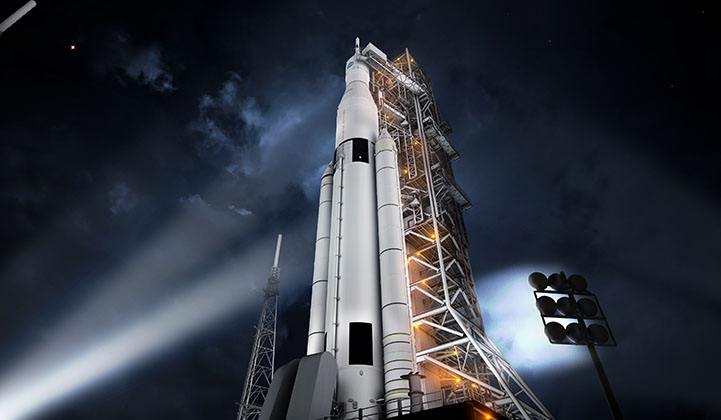
What would life be like on Mars?
Let’s assume you have no problems getting there, but what’s going to happen then? What’s your plan for all the challenges you’re going to have to deal with once you set foot on that strange Martian soil?

Earth
Earth is around 150,000,000 km from the sun
.png)
Mars
Mars is around 229,000,000 km from the sun
Breathing the Mars atmosphere
Mars has an atmosphere that’s around 100 times thinner than Earth’s, which means air pressure is significantly less on Mars than on Earth … so there’s basically no air there to breathe, and not enough pressure to keep your bodily fluids in a normal liquid state. The gases dissolved in your bloodstream would start to escape—your blood would probably literally boil. But don't worry too much, you'd pass out pretty fast. NASA scientists have used data from the MAVEN misison to figure out why Mars' atmosphere, which they believe was much thicker a long time ago, is so thin.
Just as much of an issue is the composition of what little atmosphere there is on Mars. Here on Earth, we fill our lungs with a mix of around:
- 78 per cent nitrogen
- 21 per cent oxygen
- 0.9 per cent argon
- 0.04 per cent carbon dioxide
- trace amounts of other gases
The thin Mars air is radically different (and basically toxic):
- 96 per cent carbon dioxide
- 1.9 per cent argon
- 1.9 per cent nitrogen
- 0.1 per cent oxygen
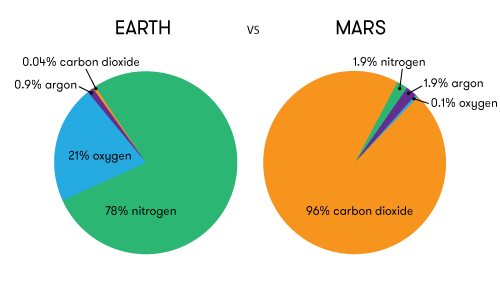
You can’t breathe this Martian air and stay alive. You’re going to need to build yourself pressurised living quarters, with an ongoing supply of breathable air and a pressurised space suit for any trip you want to take outside.
The International Space Station uses an Oxygen Generation System, which uses electrolysis to split water molecules (so you’ll also need a good supply of water) into oxygen and hydrogen atoms.
The Mars 2020 mission will send a rover to Mars with an instrument called MOXIE (which stands for Mars Oxygen ISRU Experiment). This instrument can extract carbon dioxide (CO2) from the atmosphere of Mars, then split it using electrolysis to create oxygen (O2) and carbon monoxide (CO). If the MOXIE instrument is successful, larger versions could be developed and deployed before people first land on Mars.
Finding a drink: water
Water is obviously really important—we can only survive for around three days without it. Although there are signs that there used to be significant amounts of water on Mars a long time ago, there’s not much there now.
Scientists have detected some evidence of running water on Mars, visible streaks, called recurring slope lineae, that can be seen on steep slopes that appear to come and go with the seasons. The presence of hydrated salts (chemical deposits that contain water bound up in their structure) found near these streaky formations have led the scientists to believe that these are indeed (very salty) liquid water flows.
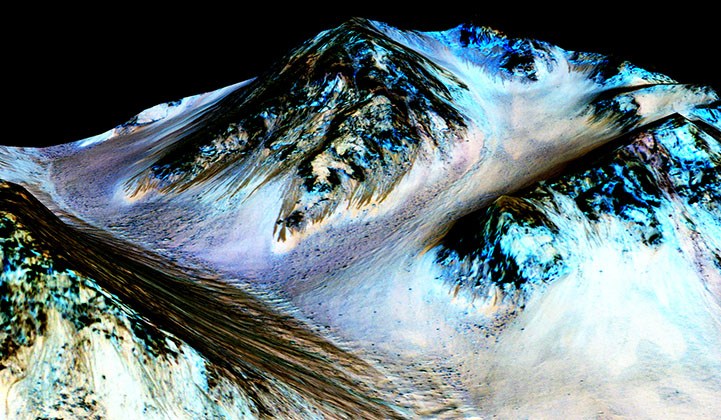
Most of the water present on Mars now is in the form of ice, although the Curiosity rover has found that at certain times of the day (night time) and year (winter) some very salty liquid water can form just beneath the surface. There are significant amounts of water (along with frozen carbon dioxide) in ice caps at the poles, but closer to Mars's equator, where you would more likely want to live, ice is only present underground and we don’t know yet how much there is.
This does provide promise for some sort of water source, but best to be prepared and be able to make your own. The International Space System uses a Water Recovery System that recycles pretty much all of their liquid wastes with a recovery rate of around 93 per cent. So get used to the idea of drinking the water from yesterday’s urine in tomorrow’s coffee. And even though 93 per cent is a pretty good recovery rate, the maths is not on your side; you’ll need a supplementary water source eventually.
And although Mars’s atmosphere is so thin, and mostly comprised of carbon dioxide, it does contain water vapour. A water vapour extraction system called WAVAR is a simple operating device that can extract water vapour from the atmosphere and condense it into liquid water. Like MOXIE, it could be deployed before humans land on Mars.
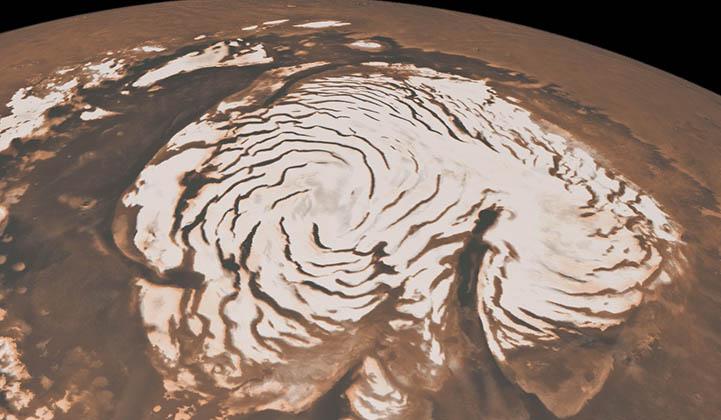
Braving the elements: weather
Although the images of Mars as the ‘Red Planet’ might evoke impressions of a hot, sweltering desert environment, it’s actually really cold. Mars’s distance from the Sun and the fact it has no atmosphere to speak of (compared with Earth, anyway) means it’s bitterly cold, with a temperature range of –140°C to 30°C (compared with –88°C to 58°C on Earth) and an average temperature of –63°C. So you’re going to need to make sure you’ve got your thermals, and some warm jumpers.
That said, the thinness of the atmosphere means you probably wouldn’t feel the cold in the same way we do here on Earth. There’ll be no wind chill on Mars, and this would bring the average Martian temperature up to a (comparatively) balmy –16°C.
The large range in temperatures means you’ll have to build things out of materials that can sustain the expansion and contraction that the persistent variation in temperatures would cause.
No need for umbrellas, though, as it doesn’t rain on Mars. However, the atmosphere is thick enough to sustain some weather, with winds, and icy clouds of water and carbon dioxide. Sometimes it even snows—super tiny flakes of frozen carbon dioxide. Not really your standard white Christmas.
The winds can create some serious dust storms, and even mini tornadoes known as dust devils. The storms are thought to be created when a wind picks up dust particles, which retain heat from the sun and create pockets of warmer air, which drives the winds to get stronger. The dust can take weeks or months to settle, and you’ll need to take into account that it might clog up or break your equipment.
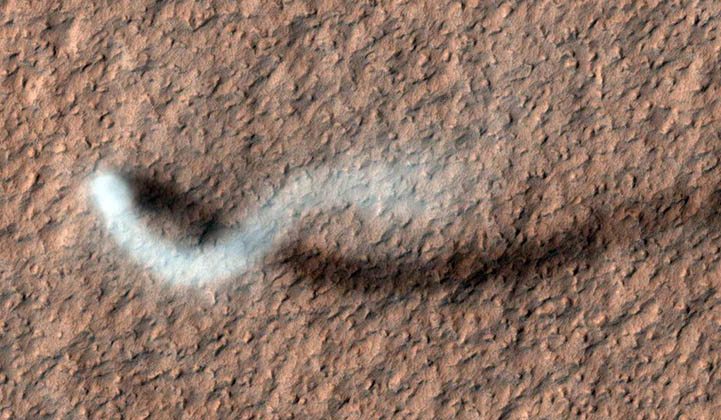
The dust storms might also be an issue if you’re depending on solar power, although the dust devils have actually been great for the Opportunity Rover, as they cleaned its solar panels, with the result that Opportunity is still operating 11 years after its expected lifetime of 90 days.
The dust is super fine, so it’s also a problem if you breathe it in. Even if you’re wearing a space suit, chances are the fineness of the dust gives it an electrostatic charge, making it really sticky. It’ll be hard to get it off your suit and you’ll likely traipse it inside whatever living quarters you’ve built.
The dust will also give the daytime light a reddish-orange tinge, and while sunsets will look generally familiar, the area around the sun will appear bluish.
Three square meals a day: food
These conditions don’t exactly make for ideal crop growing conditions and it’s unlikely you’ll be able to survive on supplies from Earth forever. Although astronauts have managed to grow lettuce in the controlled environment of the International Space Station, they used soil which is filled with the nutrients and microbes essential for plant life.
It’s not likely this will be easy to come by on Mars—you’re going to be hard pressed to grow anything in the sterile Mars soil. You’ll have to bring in some bacteria to improve the Martian soil before you can grow anything. You’ll also need to protect your plants from radiation (more about this later) and have enough water on hand for them to grow.
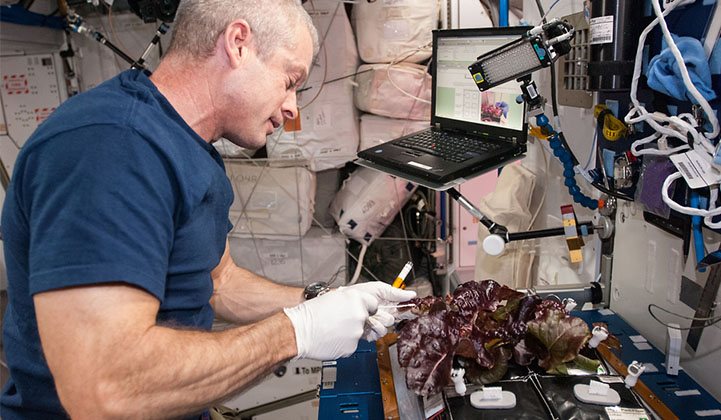
A different calendar: time
Happily, your sleep patterns aren’t going to need much resetting—the Mars day is 24 hours and 37 minutes long. So that gives you an extra 37 minutes every day to cram in all those extra tasks you always run out of time for! What might take more getting used to is the length of a Mars year—because it’s further away from the Sun, Mars’s orbit has a larger diameter and so it takes longer to complete a full revolution, around twice as long as Earth. So a Mars year is roughly two Earth years—get used to not having so many birthday parties!
The seasons, too, will be vaguely familiar, but also twice as long. Mars’s highly elliptical orbit and its slightly greater tilt means that the southern hemisphere is pointed further away from the sun when the planet itself is at its farthest away, making the southern hemisphere winters and summers much more extreme than those of the northern hemisphere.
The surface of Mars: rocks and dirt
Here on Earth we have two distinct types of crust: oceanic crust and continental crust. The oceanic crust is basically basalt (an iron- and magnesium-rich silicate rock), and although it obviously varies greatly from place to place around the world, on the whole, the continental crust is andesitic. Andesite is also a silicate rock, but contains less iron and magnesium, and more silica (SiO2) than basalt. The bulk of Mars’s surface is made of basaltic silicate rock, so very similar to the rocks of Earth’s oceanic crust.
It’s thought that the crust of Mars is just one piece, so no tectonic plates floating around causing interesting things like subduction zones and earthquakes as found here on Earth. There are some rocks that show striped magnetic reversals, which indicates that once upon a time Mars had plates that spread apart like the mid-ocean ridges on Earth do today, and a magnetic field that flipped directions (also like Earth’s).
Mars does have the largest volcano in the solar system, Olympus Mons, but it’s no longer active, so no exciting explosions of lava either. Incidentally, it’s this lack of tectonic activity that has resulted in Mars’s atmosphere being so thin: it’s thought that carbon dioxide was pulled from the atmosphere to make carbonate rocks and without any tectonic processes to recycle the rocks and degas the carbon dioxide into the atmosphere, it stayed bound up in the carbonate rocks. However, as yet, not that many carbonate rocks have been found on Mars, so this theory might not stand the test of time (and further exploration of Mars).
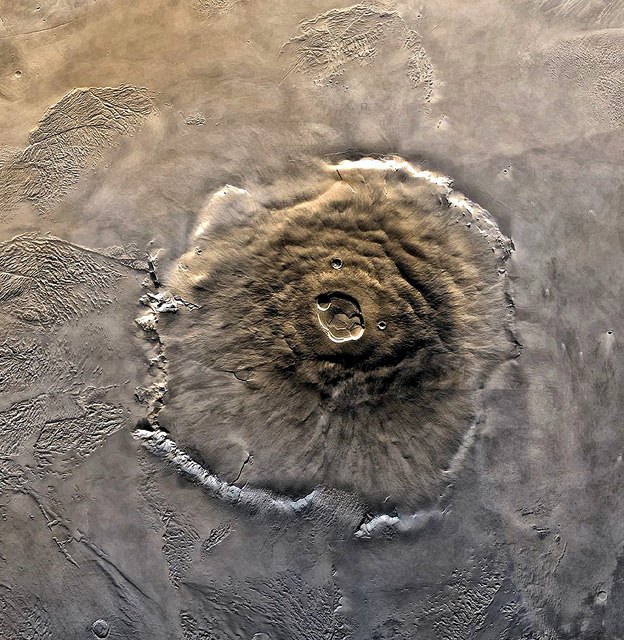
Mars earned its nickname of the ‘Red Planet’ from the dust mentioned earlier. Back when there was more water around on Mars, the iron-rich rocks on the surface oxidised (rusted), turning a reddish brown colour. When the reddish brown dust gets blown up into the atmosphere, the whole planet takes on that characteristic reddish hue we can see from here on Earth.
What’s more, the soil of some areas of Mars is toxic. The dirt at the Phoenix landing site contains perchlorates (ClO4), an oxidised form of chlorine that can harm the human thyroid, disrupting the hormones needed for normal growth and development. So this is another reason to be really careful to not breathe in any Mars dust.
The perchlorates are interesting for another reason though—many microbes here on Earth used these chemicals as an energy source, so it’s a (small) tick for evidence of possible life on Mars.
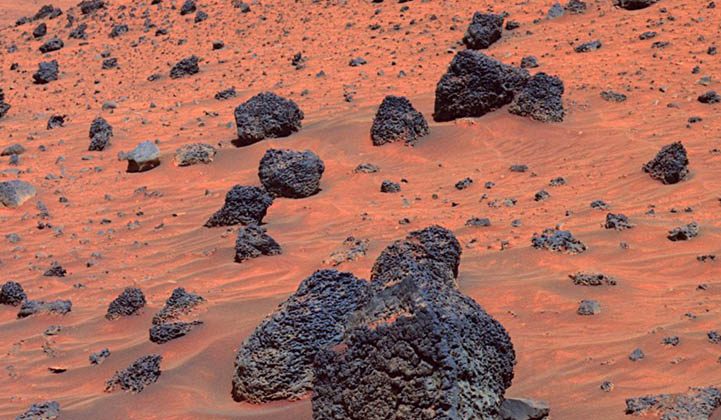
There are other rocks and structures on Mars that look like they could only have formed with the presence of water—large amounts of it. There are what appear to be layered sedimentary rocks (rocks made from grains of sand and dirt, usually laid down underwater then stuck together to make a rock) and possibly conglomerates (rocks made from pebbles and chunks of other rocks as well as sand and dirt-sized grains all stuck together).
Mars’s internal structure is probably pretty similar to Earth’s—a comparatively thin, solid outer crust, a gooey rock mantle and an inner core. While Earth has a molten outer core and a solid inner core, it’s thought that the core of Mars is entirely solid with no internal convection or fluid movement. This is important when we look at magnetic fields…
Solar radiation and magnetic fields
The sun emits a huge amount of solar radiation, including harmful (to humans) UV radiation and other high energy particles, known as solar wind. Here on Earth we’re protected from most of this by Earth’s magnetic field, which is generated by the movement within the planet’s fluid outer core.
A magnetic field exerts a force on a charged particle, and this is how it protects us from harmful high energy particles emitted by the sun. As the solar wind travels towards Earth, it is deflected by the magnetic field that surrounds our planet. Because of the structure of the field, some particles do reach the atmosphere, funnelled in at the poles, causing the stunning light shows of the Aurora Borealis and Aurora Australis.
Although there’s evidence that Mars might have had a stronger magnetic field around 4 billion years ago, the one it has now is really, really weak. This is really significant. Such a weak magnetic field provides no protection from the sun’s radiation. You’d be bombarded with cosmic rays all day long, and SPF 50+ sunscreen isn’t going to cut it. You’ll need your protective spacesuit whenever you go outside and your settlement will need to be built out of materials specifically designed to shield humans and equipment from radiation.
Terraforming Mars
Long-term habitation of Mars is unlikely to succeed without some sort of terraforming of the planet—geoengineering on a grand scale that would render the atmospheric and climatic conditions more hospitable to human life.
The biggest issue would be to create an atmosphere that’s actually breathable by humans, and enables Mars to maintain a habitable temperature. Essentially, this means triggering a ‘greenhouse’ effect where gases in the atmosphere serve to absorb and re-emit radiation (in the form of heat), preventing it from escaping back out to space.
One way to do this would be to start with some perflurocarbons, which could be made from the elements present in the soil on Mars. These would help warm the atmosphere enough to release the carbon dioxide from the polar ice caps. The carbon dioxide would help the process along, creating more warming and also increasing atmospheric pressure until you have liquid water.
Another proposal is to somehow build solar-powered greenhouse gas-creating factories that would simply spew out tonnes and tonnes of carbon dioxide, methane and chlrofluorcarbons into the Mars atmosphere.
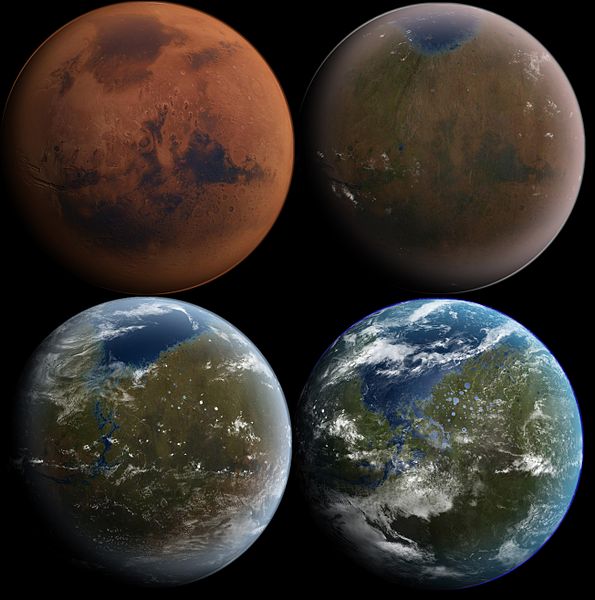
We could also take microbes, or extremely tough bacteria and lichens (like those that can live in hot dry deserts, or Antarctica) to Mars, and over a time frame of millennia, they would hopefully adapt to the conditions on Mars and create a simple biosphere that would eventually produce enough oxygen to make a breathable atmosphere.
The fact is, none of these options is particularly practical, so life on Mars is most likely going to be restricted to a life inside (or possibly underground) and any strolls outside to get a (metaphorical) breath of fresh air will have to take place within a pressurised space suit equipped with an air tank.
Mars on Earth?
Obviously, some test-runs before we merrily gallivant off to Mars would be a good idea. The Mars Desert Research Station is just one experimental set-up where researchers trial new equipment and technology in the desert of Utah, under conditions that simulate those of Mars as closely as possible.
Another consideration is to figure out how people will cope with the psychological aspects of the isolation of living on Mars—there’ll be no Skype, no Facebook, no popping out to the café to catch up over a coffee and cake. Any communications you send to Earth will take somewhere between 4 and 24 minutes to arrive, and any response will take the same amount of time. Not quite instant messaging.
One experiment involved a crew of six spending 520 days sealed up in a ‘spaceship’. Living in just three rooms the Russian crew were subjected to similar conditions to the isolation of being on Mars, such as 20 minute delays in all communications, and emerged pale but otherwise fine. However, this experiment did not replicate the danger, pressure and intensity that a true mission to Mars would evoke.
And in August 2015 six people entered a dome 11 metres in diameter and 6 metres tall on the slopes of the Mauna Loa volcano in Hawaii, where they lived for a year. Spam and powdered wine were their dietary treats, they showered just once a month, and anyone who left the dome to wander the slopes of the volcano had to don a spacesuit.
Our future on Mars
Many scientists object to the idea of one-way travel to Mars, which any human expedition in the near future most certainly would be. The moral and ethical issues with such a mission are significant. These issues must be considered even if the participants are willing to travel to Mars in full knowledge of the high risks and one-way nature of the trip—that they are truly venturing out into the frontier and they will never set foot back on Earth again. Some see this as tantamount to a suicide misison, and advocate for more robotic, rather than crewed expeditions, to further explore and understand Mars and its secrets.
Despite the many obstacles, the dream of living on Mars doggedly lives on. It will take a feat of astronomical prowess in engineering and technology to turn this dream into a reality, but research teams around the world are working towards this goal. Human ingenuity and persistence has seen science fiction become science fact many times. It could well be that one day our grandkids, maybe even our kids, will be sending us postcards from Mars.





